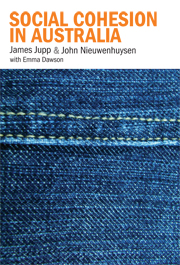Book contents
- Frontmatter
- Contents
- Foreword
- List of contributors
- List of tables
- Acknowledgments
- Introduction
- PART I DEFINING, MEASURING AND SEEKING SOCIAL COHESION
- PART II THE DYNAMICS OF SOCIAL COHESION
- PART III INFLUENCES AND RESPONSES IN SEARCHING FOR SOCIAL COHESION
- 11 Unions, the workplace and social cohesion
- 12 Education and social cohesion
- 13 The media and social cohesion
- 14 The problem of sport and social cohesion
- 15 Counter-terrorism and the politics of social cohesion
- 16 Social cohesion and human rights: would a bill of rights enhance social cohesion in Australia
- References
- Index
15 - Counter-terrorism and the politics of social cohesion
Published online by Cambridge University Press: 22 September 2009
- Frontmatter
- Contents
- Foreword
- List of contributors
- List of tables
- Acknowledgments
- Introduction
- PART I DEFINING, MEASURING AND SEEKING SOCIAL COHESION
- PART II THE DYNAMICS OF SOCIAL COHESION
- PART III INFLUENCES AND RESPONSES IN SEARCHING FOR SOCIAL COHESION
- 11 Unions, the workplace and social cohesion
- 12 Education and social cohesion
- 13 The media and social cohesion
- 14 The problem of sport and social cohesion
- 15 Counter-terrorism and the politics of social cohesion
- 16 Social cohesion and human rights: would a bill of rights enhance social cohesion in Australia
- References
- Index
Summary
My vision of the year 2000 foreshadows a greatly increasing social complexity, in which the dynamic interaction between the diverse ethnic components will be producing new national initiatives, stimulating new artistic endeavours, and ensuring great strength in diversity. In foreshadowing the future character of this interaction, we do little service to our history to imagine that Australia could ever have become a pale reproduction of Britain, a pseudo-America, or a make-believe Asia. In this respect we have always diverged from the ethnically static societies of the Old World and share the potential dynamism of the developing societies of the New World.
(Grassby 1973)In his report to the NSW government on the Cronulla riots of December 2005, retired NSW Police Commissioner Norm Hazzard ventured that ‘our multicultural society has now entered a new phase’. Comparing the events in beachside Cronulla with those in the depressed outlying Paris housing estates some months earlier, Hazzard argued that the use of ‘racial profiling’ by police should now be accepted and supported by Australia's ethnic communities. What was quickly lost in the outcry over the use of racial profiling that followed was Hazzard's report's acknowledgment that ‘an increase in the level of crime perpetrated in south east Sydney by youths of Middle Eastern background cannot be established as a cause of the riot’ (Salusinsky 2006).
- Type
- Chapter
- Information
- Social Cohesion in Australia , pp. 182 - 190Publisher: Cambridge University PressPrint publication year: 2007
- 3
- Cited by



